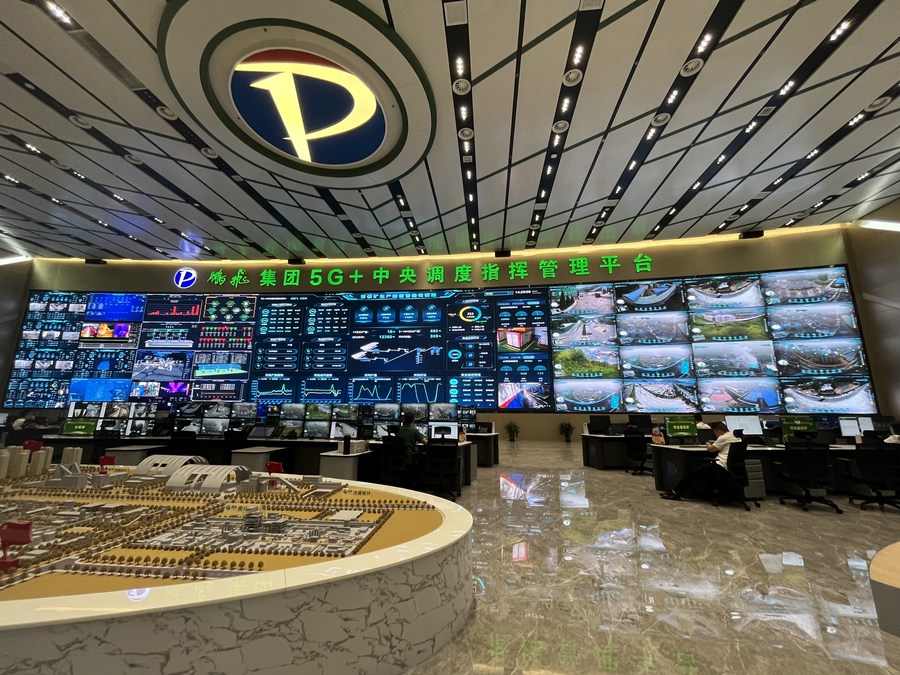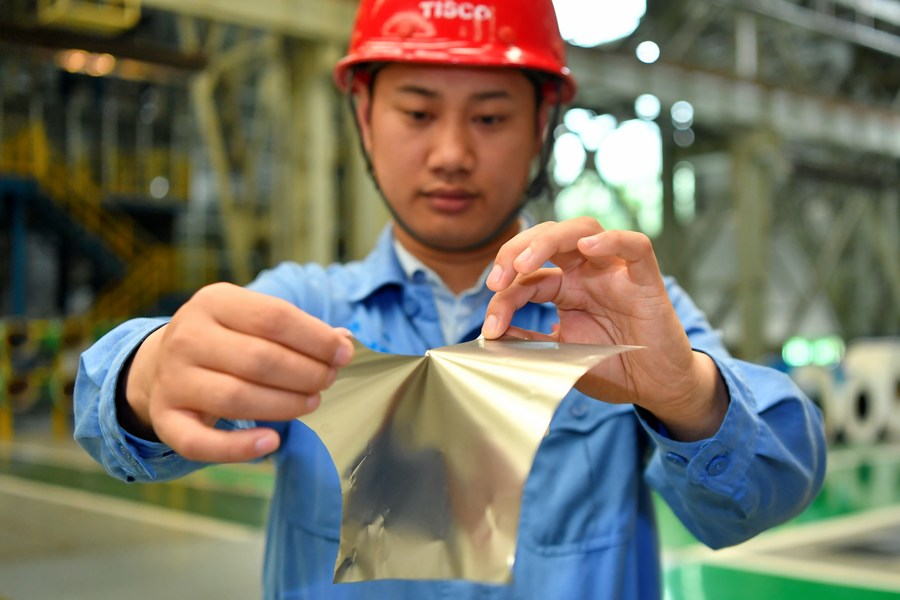Major coal producer Shanxi speeds up green transformation
* Shanxi, a major coal producer in north China, has made continuous advances in green development over the past decade.
* Thanks to the province's unremitting efforts, its industrial structure has been continuously upgraded, with emerging industries expanding and the ecological environment steadily improving.
* Shanxi's transition mirrors China's green development endeavors in boosting high-quality growth.

Photo shows the 5G-powered central management platform of Pengfei Group in north China's Shanxi Province, Aug. 11, 2022. [Xinhua/Wang Hao]
TAIYUAN -- Shanxi, a major coal-producing province in north China, has made continuous advances in green development over the past decade.
Thanks to the province's unremitting efforts, its industrial structure has been continuously upgraded, with emerging industries expanding and the ecological environment steadily improving.
GREEN MINING
In the Yitang coal mine, the city of Jiexiu, several machines can be seen operating in full swing to reinforce the underground aquiclude.
"This is called water-retention mining technology, which can prevent water inrush accidents and reduce the damage to groundwater resources," said Li Shi, chief engineer of the mine.
Previously, exploiting 1 tonne of coal needed to consume 2.48 tonnes of water. Though the new technology has increased the cost of coal mining by about 20 yuan per tonne (about 2.9 U.S. dollars), it has significantly lowered the impact on water resources, Li explained.
The water-retention technology has worked well over the past two years and could be applied in more areas, he added.
Shanxi is currently pushing forward green mining in 40 coal mines as pilot projects. The province aims to establish a long-term mechanism for clean coal production by 2035.
On the 5G-powered central management platform of Shanxi Pengfei Group, the production and operation of a coal mine some 200 km away are displayed in real time. These real-time images can even be viewed on a mobile phone app.
"If there's a potential risk in safety, we would be notified in just one second via the digitized system," said Liu Feng, head of the group's digital intelligence center.
Thanks to the new technology, the production efficiency of the coal mine has risen by 40 percent.
Shanxi's transition mirrors China's green development endeavors in boosting high-quality growth. By leveraging cutting-edge technology, China has proposed that by 2035, all types of coal mines will be basically intelligent.
Meanwhile, the country is upgrading its energy structure by shifting more to clean energy.
As of June, the installed new-energy power capacity in Shanxi was 40.12 million kW, accounting for 34.46 percent of the total installed power-generating capacity in the province.

A worker of Taiyuan Iron and Steel (Group), or TISCO, tears up a piece of 0.02-mm-thick ultra-thin stainless steel strip, in north China's Shanxi Province, May 24, 2019. [Xinhua/Cao Yang]
EMERGING INDUSTRIES BOOMING
While transforming and upgrading traditional industries, Shanxi is striving to develop emerging industries.
After more than 700 failures and overcoming over 600 problems, Liao Xi and his team finally produced ultra-thin steel as thin as 0.02 mm.
"After approximately five years of experiment, we finally achieved success," said Liao, a 36-year-old technician with Shanxi Taigang Stainless Steel Precision Strip Co., Ltd.
The "hand-tearable steel" is a high-end product mainly used in flexible display screens, precision instruments and the aerospace sector.
Such a success epitomizes Shanxi's efforts to accelerate industrial transformation by expanding its presence in emerging industries, such as high-end equipment manufacturing, big data and new energy sectors.
Considered as "the energy of the 21st century," hydrogen energy is listed by Shanxi as a pioneering future industry during the 2021-2025 period.
In July, the Beiyao integrated hydrogen station of Shanxi Pengfei Group started operation in the city of Xiaoyi, and a hydrogen-powered heavy truck successfully completed hydrogen filling.
"Each year, 10,000 hydrogen-powered heavy-duty trucks can reduce carbon emissions by 140 tonnes," said Suo Shengfu, chief director of the hydrogen port project under Shanxi Pengfei Group.
"Hydrogen can be extracted more easily from coke-oven gas, a by-product in coke production, realizing efficient conversion of 'black' coke to 'green' hydrogen energy," Suo said.

Aerial photo taken on July 10, 2022 shows a view of the Xiaohe National Wetland Park in Xiaoyi City, north China's Shanxi Province. [Photo by Wu Jinzhou/Xinhua]
"GREEN GREAT WALL"
The Yungang Grottoes is a UNESCO World Heritage site featuring over 50,000 pieces of stone Buddhist sculptures in the city of Datong. Some of the statues, however, were covered with ash and dust some 30 years ago.
"Areas in its vicinity boast rich coal resources, and trucks loaded with coal could be seen racing day and night with floating ash staining the statues," said Wang Heng, a Yungang Grottoes researcher.
Datong has since taken a number of measures to curb pollution induced by coal, such as adjusting the industrial structure, phasing out outdated production capacity, and strengthening oversight and regulation.
These efforts paid off and in 2021, the city ranked first in air quality across the province.
The campaign to build a "green Great Wall" is also underway.
Lyu Fuqin, a resident of Huoliaopo Village in the city of Lyuliang, can earn over 40,000 yuan every year by taking part in the province's afforestation initiative. He planted 20 mu (about 1.3 hectares) of locust trees and apricot trees in the mountain this spring and plans to grow more this autumn.
In the past decade, more than 4 million mu of trees were planted every year in Shanxi, and the forest coverage rate of the province increased from some 18 percent in 2010 to 23.57 percent in 2020, exceeding the national average.
The improved environment has also resulted in a tourism boom.
Li Zhenjiang, 31, earned more than 100,000 yuan last year by working in a local travel agency and running two souvenir shops after returning from Beijing to his home village of Dazhai in Xiyang County.
"Now I no longer have to run around and can have a decent life in my hometown," he said.
Video reporters: Chen Zhihao, Shen Feng, Zhao Yang; Video editors: Jia Xiaotong, Hui Peipei, Zhao Yuchao and Zhu Jianhui
























